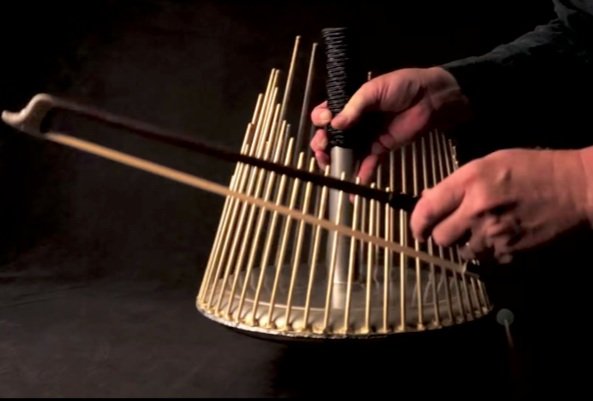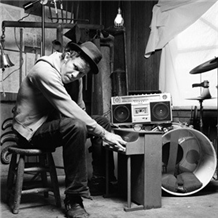Resonant, expressive, and eerily strange, this inharmonic idiophone instrument invented by Richard Waters in 1967 consists of a stainless steel resonator bowl or pan with a cylindrical neck and bronze rods, played by hand, with soft mallets or a bow. The resonator normally contains small amount of water to add to its sonic effects depending on whether the instrument is held vertically (lowering the tone) or horizontally (raising the tone), with added acoustic, schiziosonic modulations. This comes from pre-echoes in the motion of the water and the relative speed of sound in water, air and metals. It’s an instrument ideal for sound effects in film music, or contemporary classical or other genres from jazz to pop, emanating everything from ghostly horror scenes to mesmeric whale song. When immersed in water, it has even been used to call whales. It has been made in four sizes from the Standard (7" diameter), the Whaler (12" diameter), the Bass (14" diameter) and the MegaBass (16" diameter). Here are a couple of demonstrations, first, by the inventor himself playing the largest of these:
And more by Todd Barton playing a new Brooks Hubbert model:
And here is an entire playlist of different effects by musical experimentalist Dracosonic:
Tom Waits is a fan of many oddball instruments, including the waterphone
The waterphone has featured prominently in avant gard music of all kinds. Tom Waits is a keen collector of the instrument, which has featured in much of his work, including Moanin' Parade & Swarm Warnings (Gatmo, 2000), an album which also features Richard Waters among others.
There are several albums and collections devoted entirely to the instrument, such as Richard Waters & Friends on Water Dreams (The Orchard Records, 2000), Robert Minden Ensemble - The Boy Who Wanted To Talk To Whales (Otter Bay Recordings, 1989) and other albums, Toshiyuki Hiraoka - Waterfone (Hard Disc Intl, 2015), and Howard Goodall’s The Dreaming, inspired by Shakespeare's A Midsummer Night's Dream. Other composers who have utilised it include Sofia Gubaidulina, Jerry Goldsmith, John Mackey, Christopher Rouse, Colin Matthews, John Woolrich, Carson Cooman, Andi Spicer, Ludovico Einaudi, Andrew Carter, and Bernie Krause of Beaver & Krause.
Here’s an excerpt from Robert Minden’s album:
A favourite of the movie sound-effect specialist, the waterphone has also been used in many films, including Poltergeist, Alien, The Matrix, Star Trek: The Motion Picture, and Crouching Tiger, Hidden Dragon. These are familiar sounds from any of them:
So then, any more waterphone-based music or cultural references come to mind? Feel free to share any further ones from songs, or even film, art or other contexts in comments below.
You can also get in touch the contact page, and also visit us on social media: Song Bar Twitter, Song Bar Facebook. Song Bar YouTube. and Song Bar Instagram. Please subscribe, follow and share. New to comment? It is quick and easy. You just need to login to Disqus once. All is explained in About/FAQs ...
Song Bar is non-profit and is simply about sharing great music. We don’t do clickbait or advertisements. Please make any donation to help keep the Bar running:


